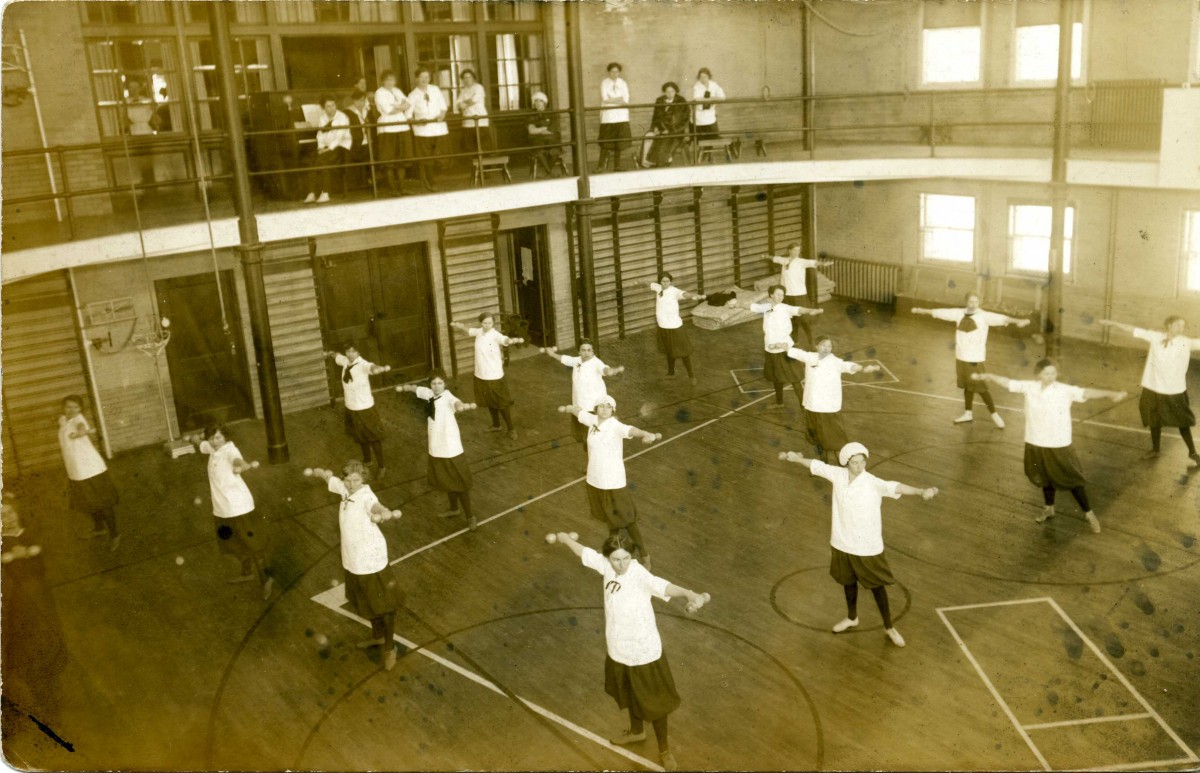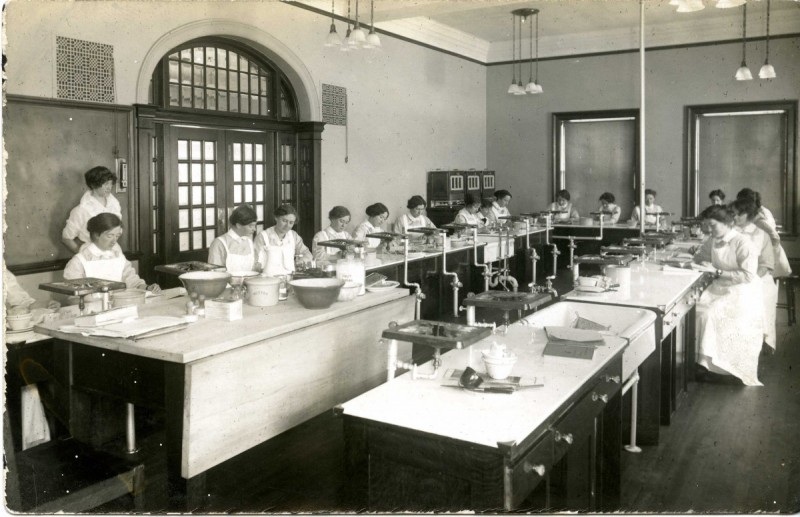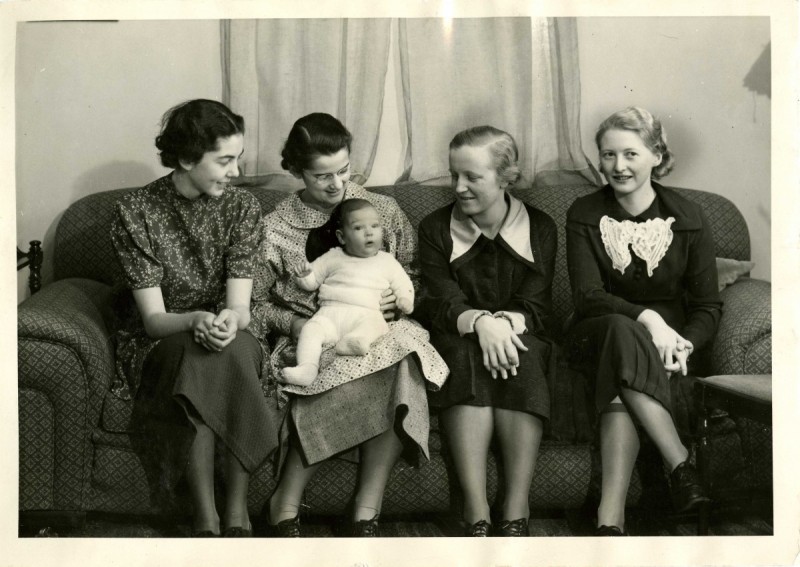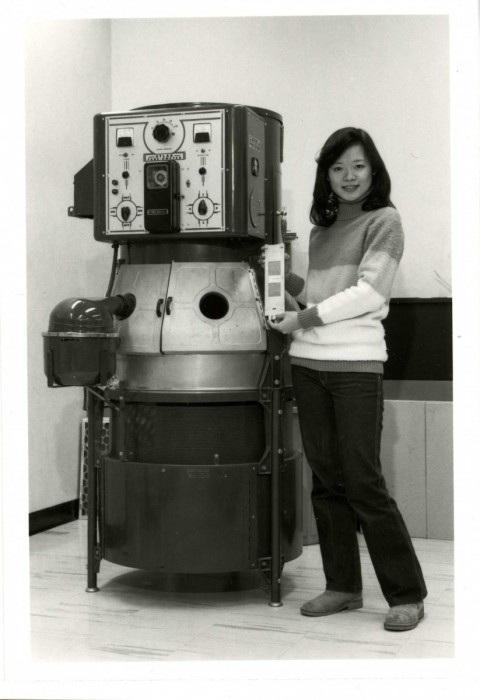
Gymnasium at University Residence (Tache Hall) taken between 1914 and 1915 // Photo from Archives and Special Collections
Five stories, 105 years
Always evolving to reflect the educational and research needs of a changing society
Throughout its 105 year history at the University of Manitoba, the study of Human Ecology has evolved to reflect the educational and research needs of a changing society.
The following stories are adapted from More than Memories: Stories from our past, a book produced for Human Ecology’s centennial year in 2010.
The Beginning
In 1909, the courses of study, staff members, and all other required pieces were put together and the first group of girls began their studies in Household Science on May 3, 1910. In order to apply, the girls had to be 18 years old and able to prove evidence of moral character. They needed a certificate of health signed by their parents and had to convince College authorities that their English education was sufficient for them to succeed in their lectures and subsequent exams. There is no mention of how these students were able to provide evidence of moral character in the College General Calendar, but it is very clear that any bending of the rules would result in expulsion.
Courses listed in the 1910/11 General Calendar include Management of Home Poultry, The Home Garden, Meat-cutting demonstration, and Beekeeping.
Changing to meet needs of community
In 1911, a Home Economics car was added to the Better Farm Trains that traveled around rural Manitoba giving short courses to people in rural communities. Courses were offered in Agriculture as well as the new home economics topics ranging from food safety to care of the sick. This was the beginning of agricultural extension work, which defined the history and the faculty for many years.
In 1933, the provincial extension program was becoming bigger and the demand for trained extension workers from the degree program was high. The Depression and both world wars provided new educational and research opportunities.
The “Practice House”
The first mention of actual care of children was in 1929 when, under the supervision of Florence McLauchlin, two children were cared for in the Sprague House by the students in Household Management. In 1931, when Home Management was relocated to the Farm Cottage, a separate course in child care was introduced in the fourth year degree program requiring each student in the House to be Child Director for a period of time.
After years of reports to the President of insufficient space and poor heating in the “farm house,” a new red brick Georgian-style residence, designed by Ralph Ham specifically for the Department of Home Economics “to accommodate ten students and a baby.” Known as the “Practice House,” it has been immortalized by the late Carol Shields, Pulitzer Prize-winning author, in her novel Republic of Love.
From 1929 to 1953, thirty-three children, mostly babies, received the loving care of Miss McLauchlin, known as “Mac” amongst her colleagues and friends, and her Home Ec students.
After 1945, when veterans of World War II flocked to the university, many brought their wives and families who lived lived on campus in special student housing popularly known as the “Veteran’s Village.” The basement of the new Management House was used two afternoons a week as a playroom or nursery school for their children. With about 20 two- to five- year-olds attending, “the small nursery school served as an observation laboratory for students.”
The Story of Canola
The University of Manitoba is recognized nationally and internationally as having played a role in the development of canola but credit is usually limited to the contribution made by the plant breeders (in particular, Dr. Baldur Stefansson) in the Department of Plant Science. The contribution by Foods and Nutrition is not as well known.
Dr. Vivian Bruce and Dr. Bruce McDonald were the first researchers to feed canola oil to human subjects under carefully controlled experimental conditions. These early studies found canola oil as effective as sunflower oil and soybean oil in lowering blood cholesterol.
Parallel to the nutrition studies were studies by Professor Marion Vaisey-Genser, Dr. Michael Eskin and later, Dr. Lina Malcolmson on the shelf-life and deep-fry stability of canola oil and canola shortening. These researchers adopted and perfected methods for assessing the shelf-life of canola oil and for comparing its stability with other edible vegetable oils.
From Textiles to Advanced Materials
The opening of the Duff Roblin Building in 1969 was a significant event in the history of textile sciences. The department now had space for a full textile lab.
A Weatherometer, the first one in Canada, was installed in the lab. This machine could expose textiles to simulated natural sunlight, rain on demand and exposure to air pollutants. The lab had equipment to assess colour fastness, abrasion, stiffness, linear density, and identify fibers and fabrics. As word of the program and the new lab spread, the textile laboratories were contacted to help with local textile problems. Clients included Gemini Fashions, JEnnis Fabrics, Syn-Tex Industries, Engineered Apparel, Warehouse One, Quinton’s Cleaners, Freed & Freed, Nygard, Bombardier, several Winnipeg hospitals, Manitoba Hydro, firefighters, and many more.
The University of Manitoba’s Archives and Special Collections’ Human Ecology fonds includes a wealth of information about the faculty through the years. The fonds was donated to University of Manitoba Archives & Special Collections by the Faculty of Human Ecology in several accessions between 1984 and 1993.
The digital photo collection can be found at http://digitalcollections.lib.umanitoba.ca/islandora/object/uofm%3Ahumanecology?display=grid
[rev_slider humanecology]
Milestones
1910 – Diploma in Household Sciences established within Manitoba Agricultural College
1915 – Diploma in Household Sciences becomes Bachelor of Home Economics
1924 – Home Economics granted Faculty status: Faculty of Agriculture and Home Economics
1943 – School of Home Economics established
1967 – Department of Foods and Nutrition & Department of Clothing and Textiles established
1970 – School of Home Economics becomes the Faculty of Home Economics
1971 – Department of Family Studies established
1981 – Faculty of Home Economics becomes Faculty of Human Ecology
1982 – Bachelor of Human Ecology degree introduced
2004 – Department of Foods and Nutrition renamed Department of Human Nutritional Sciences
2005 – Department of Clothing and Textiles renamed Department of Textile Sciences, Degree designation changed to B. Sc. (Textile Sciences), Textile product development curriculum launched
2007 – Bachelor of Health Sciences and Bachelor of Health Studies degrees introduced
2014 – Department of Human Nutritional Sciences moves to Faculty of Agricultural and Food Sciences
2015 – Department of Textile Sciences merges with Department of Biosystems Engineering, Department of Family Social Sciences merges with Department of Community Health Sciences









